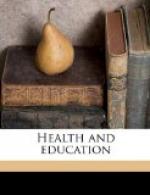“This fine tirade,” says Dr. Maurice Raynaud—from whose charming book on the ‘Doctors of the Time of Moliere’ I quote—“is not, as one might think, the translation of a piece of poetry. It is simply part of a public oration by Francois Fanchon, one of the most illustrious chancellors of the faculty of medicine of Montpellier in the seventeenth century.” “From time immemorial,” he says, “‘the faculty’ of Montpellier had made itself remarkable by a singular mixture of the sacred and the profane. The theses which were sustained there began by an invocation to God, the Blessed Virgin, and St. Luke, and ended by these words:—’This thesis will be sustained in the sacred Temple of Apollo.’”
But however extravagant Chancellor Fanchon’s praises of his native city may seem, they are really not exaggerated. The Narbonnaise, or Languedoc, is perhaps the most charming district of charming France. In the far north-east gleam the white Alps; in the far south-west the white Pyrenees; and from the purple glens and yellow downs of the Cevennes on the northwest, the Herault slopes gently down towards the “Etangs,” or great salt-water lagoons, and the vast alluvial flats of the Camargue, the field of Caius Marius, where still run herds of half-wild horses, descended from some ancient Roman stock; while beyond all glitters the blue Mediterranean. The great almond orchards, each one sheet of rose-colour in spring; the mulberry orchards, the oliveyards, the vineyards, cover every foot of available upland soil: save where the rugged and arid downs are sweet with a thousand odoriferous plants, from which the bees extract the famous white honey of Narbonne. The native flowers and shrubs, of a beauty and richness rather Eastern than European, have made the ‘Flora Monspeliensis,’ and with it the names of Rondelet and his disciples, famous among botanists; and the strange fish and shells upon its shores afforded Rondelet materials for his immortal work upon the ‘Animals of the Sea.’ The innumerable wild fowl of the “Bouches du Rhone;” the innumerable songsters and other birds of passage, many of them unknown in these islands, and even in the north of France itself, which haunt every copse of willow and aspen along the brook sides; the gaudy and curious insects which thrive beneath that clear, fierce, and yet bracing sunlight; all these have made the district of Montpellier a home prepared by Nature for those who study and revere her.
Neither was Chancellor Fanchon misled by patriotism, when he said the pleasant people who inhabit that district are fit for all the labours of the intellect. They are a very mixed race, and like most mixed races, quick-witted, and handsome also. There is probably much Roman blood among them, especially in the towns; for Languedoc, or Gallia Narbonnensis, as it was called of old, was said to be more Roman than Rome itself. The Roman remains are more perfect and more interesting—so the late Dr. Whewell used to say—than any




